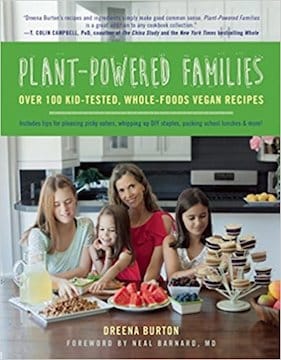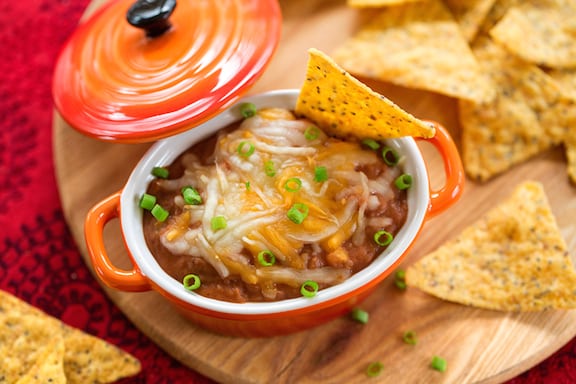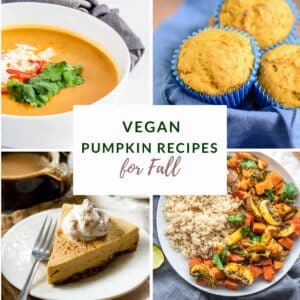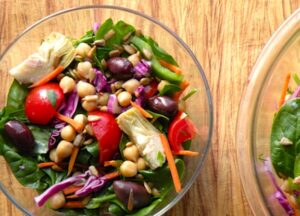The number of vegan kids has increased exponentially in recent years. Well-planned vegan diets are safe and offer health advantages, even for growing children. Talk to your practitioner and read up on the subject. Here are some practical tips for parents for dealing with everyday situations. Make sure to see the companion to this article by PCRM, The Vegetarian and Vegan Diet for Kids, as well as 10 Tips for Raising Vegan Children. Photo above: Pineapple Veggie Pita Bread Pizza by Vicki Brett-Gach.
School Lunches / Snacks
It would truly be a challenge to find a classroom where every student eats the same foods. Lactose intolerance, food allergies, ethnic preferences, and religious or dietary restrictions all influence food choices. The classroom can provide an opportunity to introduce students and teachers to healthy foods. Fresh fruit, veggies cut into fun shapes served with bean dip, muffins, and crackers spread with nut butter and fruit, are all healthy, delicious snacks. See lots more in VegKitchen's Healthy School Lunch article.
Be sure to discuss food issues with your child’s teacher. Find out if the teacher has any classroom rules regarding foods. For example, some teachers may not allow candy or other sweets to be eaten in the classroom-a sign of helpful nutritional interest and concern.
Discuss the reasons that your child follows a vegan diet and provide the teacher with nutrition information. Airing these issues ahead of time helps head off problems by familiarizing the teacher with vegan diets. Donating books or cookbooks to the school library is helpful. It’s also useful to link up with like-minded parents for mutual support.
The variety of vegetables, legumes, grains, and fruits available can make for interesting school lunch fare. For parents concerned that their child’s meal will be “different,” try meat analogs, nondairy cheese, or nondairy yogurt. Leftovers are another quick and easy lunchtime alternative. Experiment with these suggestions:
- Sandwiches — Try hummus or another bean spread with sliced tomatoes, cucumbers, and shredded carrots in pita bread. Many whole foods stores and some grocery stores sell vegan deli slices that look and taste like bologna, Canadian bacon, roast beef, and turkey. Serve on whole-grain bread with soy cheese, mustard, lettuce, and tomato. Peanut butter is an old standby. For variety, try other nut butters, such as cashew, almond, or hazelnut, with sliced banana or peaches on whole wheat bread. Cutting sandwiches into novel shapes is fun for kids.
- Hot meals — Fill a wide-mouth thermos with just-made or leftover pasta and tomato sauce, hearty bean soup, veggie chili, or stew. Or make your own vegetarian version of “franks & beans” using vegetarian hot dogs and vegetarian baked beans.
- Soups — Warm your child with homemade vegetable or bean soups. If you are short on time, try a low-sodium instant soup. Just stir hot water into the soup mix and pour into a thermos. Round off the meal with some crackers, crunchy baby carrots, and soy or rice milk.
- Side dishes — Choose a couple of the following suggestions to complete your child’s meal: individual boxes of soy or rice milk, soy yogurt, chopped vegetables and dip, whole grain breads or crackers, homemade muffins, rice cakes, pretzels, or fresh fruit. Although the United States Department of Agriculture still mandates that cow’s milk be served with school lunches, many schools will allow juice to be substituted, if you present a physician’s note.
Dreena Burton's Plant-Powered Families is a great resource
Birthday Parties
Whether the celebration occurs at school or at home, your child needn’t feel like an outsider. If the celebration is for another child, offer to bring a dish or dessert to the party. Some popular foods are listed below:
- Hot dogs — Vegan versions of the traditional meat hot dogs are widely available. Try some of the following brands: Lightlife Smart Dogs or Tofu Pups, Yves Veggie Weiners or Tofu Weiners. Sauerkraut, relish, ketchup, and mustard go well with any of these.
- Hamburgers — Many types of vegan burgers are available in grocery stores or whole foods stores. Try some of the following brands: Boca Burgers, Garden Vegan, or Harvest Burgers. Allow children to add their own toppings-ketchup, mustard, pickles, onions, lettuce, tomato, or relish.
- Pizza — Spread tomato sauce on plain bagels or English muffins and have children top them with a variety of fresh vegetables, such as chopped onions, mushrooms, peppers, broccoli, or olives. Add a sprinkle of soy cheese for more flavor. If you have time, make or purchase pizza dough and cut the dough into a variety of shapes. Have the kids add the toppings and bake.
- Dessert — Try fruit smoothies using nondairy milk and frozen fruit. Watermelon slices always go over well with kids. Or prepare a fruit salad, cutting the fruit into a variety of shapes.
If you're making a cake or cupcakes, try some of the following suggestions for replacing eggs and/or dairy in the recipe:
- To replace eggs in baked goods, substitute 2 tablespoons of cornstarch, 1 ounce (2 tablespoons) soft tofu, ⅓ cup applesauce, or ⅓ cup pumpkin for each egg. Half of a small mashed banana can also replace each egg-and tastes great in pancakes or muffins. Commercially prepared substitutes such as Ener-G Egg Replacer (a mixture of potato starch, flour, and leavening) can also be used per package instructions.
- Replace milk with nondairy milk, cup for cup, in any recipe. For buttermilk, substitute each cup with 1 cup of nondairy milk plus 1 tablespoon of vinegar. For yogurt in recipes, replace each cup with ¾ cup nondairy milk plus 1 tablespoon of vinegar.
How to Feed a Picky Toddler
Whether omnivore or vegetarian, toddlers will take a stand on what they will or will not eat. There is no obvious rhyme or reason to this, and it can make providing a nutritious, balanced meal a real challenge. These tips may help.
- Involve your child in meal preparation. Let your toddler mash a banana or add some dried raisins to a recipe. Explain what you are preparing, and if you can be flexible about the ingredients, let the toddler choose.
- Children learn by example. Eat the same vegetarian foods as you serve your child. They are healthy for both adults and children.
- If a toddler refuses a food the first time it is offered, don’t give up hope. Sometimes it takes several tries for a child to accept a new food. Offering a small amount of the new food with something familiar-and well-liked by the child-may help. Or, if a food isn’t accepted in one form, try another. For example, if a child doesn’t like chunks of tofu, try making it into a dip and serve with steamed vegetable strips.
- If your child dislikes plain nondairy milk, try various flavors. Mix with hot or cold cereal; use in pancakes or muffins; or blend with fruit to make a shake.
- Keep the dishes simple and don’t pile on the food. A complicated unfamiliar dish that covers the plate may seem a bit daunting to a child. Simple finger foods-steamed vegetables strips, crackers, or chunks of cooked tofu make eating easy and fun for a child.
- Include favorite or familiar foods in a variety of recipes. Cook rice in a mixture of fruit juice and water, or thin nut butter with some almond milk to make a pasta sauce.
- If a child refuses vegetables, use subterfuge. Try finely shredding dark green leafy vegetables or carrots and adding to tomato sauce or loaf mix. Mix vegetables with grains and wrap in a tortilla. Or, if your child likes mashed potatoes, add in some finely shredded vegetables, such as zucchini or squash.
Quick and Easy Meals
Parents with little time to cook can still serve nutritious, delicious vegan meals for their families, and will enjoy not having to clean messy chicken grease or risking foodborne illness from undercooked animal products. Convenience foods available in grocery and health food stores can make preparing meals a snap. Here are some quick meal solutions:
- Plan for leftovers. Cooking soups, sauces, or main dishes in batches can save lots of time. Store extras in individual microwavable containers, then label and freeze or refrigerate them for later use. Grains can be cooked in quantity and used over several days. Last night’s rice can be tonight’s rice pudding.
- Save time at the store by planning your meals ahead. Pick a few recipes and use the ingredient list as your shopping list.
- Try low-salt vegetarian soups in cans or cups. Some soups are quite thick and can even be used as sauce over pasta, potatoes, vegetables, or rice. Opt for BPA-free cans.
- Canned vegetarian chili or refried beans are useful! They can be heated and served over leftover rice. Add refried beans, tomatoes, lettuce, and salsa to a flour tortilla. Roll and serve.
- Add protein with veggie hot dogs. sliced vegetarian hot dogs to vegetarian baked beans.
- Tempeh and baked tofu come in great flavors. Just heat and served
- Spread bean dip on bread. Or serve with raw vegetables. Try VegKitchen's Easiest Hot Bean Dip. (photo above)
- No time to chop vegetables? Try buying baby carrots; pre-washed lettuce, spinach, or other mixed greens; frozen chopped vegetables; or buy precut, cleaned vegetables from the salad bar.
- Most fruit need only be washed or peeled and is ready to eat. Try fresh apples, oranges, peaches, pears, or grapes. Fresh fruit that takes a little more work, such as fresh pineapple, mango, papaya, guava, cantaloupe, or honeydew, can be purchased pre-peeled and chopped.
- Use frozen organic fruit to make smoothies. with a little nondairy milk for a delicious fruit smoothie: a healthy alternative to ice cream! Dried fruits are another option requiring no more work than opening the bag.
What to Tell Grandparents, Teachers, Friends, Babysitters…
The saying, “Grandma knows best,” may not always apply when it comes to feeding your child. If her idea of a wholesome meal consists of meat, potatoes, and a boiled vegetable, it’s time to have a serious talk. It’s important to discuss with those who may, at some point, be involved with feeding your child. Try these tips:
- Be specific about the foods your child does not eat-meat, poultry, fish, eggs, dairy, gelatin, honey, and meat broth. Friends and family may be unaware of the “hidden” sources of animal products in foods. Providing them with information or a list of foods and snacks that your child eats will help to eliminate uncomfortable situations later.
- Find common foods and dishes. Various dishes popular with omnivores and vegetarians alike are free of animal products-pasta with marinara sauce, peanut butter and jelly, and others.
- Share recipes with family and friends. When your child attends a birthday party, offer to make a dish or dessert and pass along the recipe.
- Give a gift subscription to a vegetarian publication or give a vegetarian cookbook. This will help others understand more about the diet and encourage them to try out some of the recipes.
- When your child stays with a friend, send along a dish or brown bag meal that your child—and friend—can eat.
Nutrition Panel: Patricia R. Bertron, R.D., Carol M. Coughlin, R.D., Suzanne Havala, M.S., R.D., L.D.N., F.A.D.A., Virginia Messina, M.P.H., R.D., Neal D. Barnard, M.D.
Reprinted by permission of the Physician’s Committee for Responsible Medicine.
- Explore lots more healthy eating tips on VegKitchen’s Veg Kids and Teens page as well as in the Nutrition area.
- For lots more features on healthy lifestyle, please explore VegKitchen’s Healthy Vegan Kitchen page.
*This post contains affiliate links. If the product is purchased by linking through this review, VegKitchen receives a modest commission, which helps maintain our site and helps it to continue growing!








Comments
No Comments